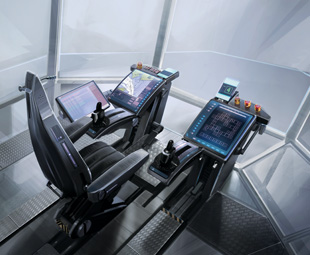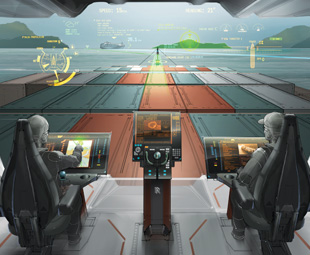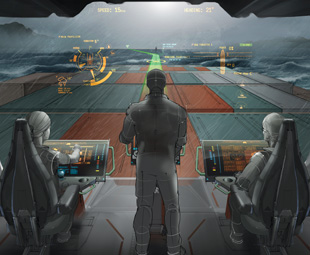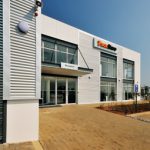Nautical newcomer?

Few things in life can compensate for skills, as expertise keeps any industry moving … and the shipping sector is in the same “boat”. But technology does make life a lot easier and know-how can be fostered. Enter augmented Rolls-Royce reality and skills development at a local river port.
Rolls-Royce Marine (yip, these guys don’t only build luxury automobiles) struts some impressive capabilities in the marine market; encompassing the design, supply and support of power and propulsion systems. Mikael Makinen, president of Rolls-Royce Marine, says it best: “Innovation remains an important differentiator, as technology will address the future challenges related to the environment and the cost of owning and running vessels.”
Rolls-Royce Marine, along with VTT Technical Research Centre of Finland (a multi-technological research organisation that creates new technology and science-based innovations in cooperation with various partners globally), has reaffirmed this with a concept video that showcases new solutions for crews manning the bridges of tugs, cargo ships and platform supply vessels in the year 2025.
In the 3D rendering – made by TrollVFX, a visual effects house based in Finland – smart workstations, which automatically sense the user and adjust themselves based on who sits down, adorn the ship bridges of 2025. And the windows on the bridge aren’t merely there so that you can look outside … They serve as a heads-up display, showing navigation information and the routes of one’s own ship as well as those of others.
Augmented reality technology enables crew members to keep an eye on obstacles that would otherwise be obscured by distance or weather. There is also an ice analyser, which indicates whether the planned route is safe and economically feasible.
 In the future, however, it will still be important for watchmen to keep their eyes on the sea … and the bridge of the future will make this a lot easier. For instance, when it’s dark, the window displays thermal camera images directly over the “external world”, enabling the observer to remain focused on the ocean ahead.
In the future, however, it will still be important for watchmen to keep their eyes on the sea … and the bridge of the future will make this a lot easier. For instance, when it’s dark, the window displays thermal camera images directly over the “external world”, enabling the observer to remain focused on the ocean ahead.
This isn’t a mere figment of some 3D animator’s imagination, projecting what seafaring could be like a decade from now … VTT and Rolls-Royce combined their research of crew operations, future studies and user experience design before creating the motion picture. Crew members, including ship captains and first mates, were also consulted to evaluate ideas contributing to safety, energy savings and functionality.
The system is also backed by Finnish Metals and Engineering Competence Cluster’s (FIMECC’s) user experience and usability in complex systems (or UXUS) programme. FIMECC is a research and development company with expertise in metals and engineering.
“The project has successfully combined experience-driven design, in-depth psychological and operational analysis of tasks and the envisioning of future technological solutions. These have been packaged in the form of impressive, futuristic videos that will inspire participants in this field to adopt user experience-based solutions,” says Maaria Nuutinen, programme manager.
This major collaboration demonstrates what could be achieved by 2025 in the shipping industry and aims to renew the thinking of key players in this field. Most of the solutions are actually a current possibility with existing technologies, but it will take time for the feasibility studies to catch up.
This isn’t the only innovation to come from FIMECC’s UXUS project as VTT, Rolls-Royce Marine and the University of Tampere are studying the remote control of ships – with the project set for completion next year.
These vessels of the future will still need to be repaired and maintained, however, despite the implementation of hi-tech bridges or remote-control capabilities … and this requires the necessary skill set. “In a highly competitive and labour-intensive sector, such as the maritime industry, one cannot overstate the importance of sustainable job creation and ongoing skills development,” says Rob Deane, general manager of Elgin Brown & Hamer South Africa (EBH SA) – a ship repair company with almost 140 years’ experience.
Unfortunately, the industry is facing a skills crisis … “The current skills crisis is compounded by the challenge of an experienced, but ageing, workforce,” Deane explains. “It is incumbent not only on individual companies, but the entire maritime industry of South Africa, to proactively grow our skills base.”
EBH SA is ideally suited for this task as it was acquired by the DCD Group in 2012, forming the DCD Marine Cluster. Other parties include DCD Marine Cape Town and EBH Namibia – “uniting” shipyards locally and abroad as the group has facilities in Cape Town, Walvis Bay, Saldanha, Ngqura, East London and Durban.
 Marius Botha, general manager of EBH SA’s East London branch, adds that the DCD Marine Cluster has adopted a group approach; “This means aligning ourselves with the rest of the cluster, with a strong focus on resource sharing and skills exchange between ourselves and our counterparts in Durban and Cape Town,” he says.
Marius Botha, general manager of EBH SA’s East London branch, adds that the DCD Marine Cluster has adopted a group approach; “This means aligning ourselves with the rest of the cluster, with a strong focus on resource sharing and skills exchange between ourselves and our counterparts in Durban and Cape Town,” he says.
He adds that the East London shipyard – the only river port in South Africa – is fast becoming a ship repair destination of choice along South Africa’s east coast, catering especially to the growing offshore oil and gas industry.
“Our superintendents and artisans in marine, painting and mechanical services have decades of experience between them, and for many this includes international exposure. This level of expertise is invaluable in the shipping industry,” Botha points out.
“It is critical that these skills are passed on to more junior members of our team, however, to ensure organisational continuity and sustainability,” he continues. “That is why we have embraced a drive towards training and skills development.”
The company’s focus on training takes the form of both informal skills exchange programmes, with the other EBH shipyards, as well as in-house mentoring of apprentices under the supervision of EBH East London’s own artisans.
The company also regularly invites students, from local Further Education and Training colleges, to spend time in the working environment. These training days focus on areas which they are studying, for example, the field of project management.
“We recognise the skills shortages in our sector, which is why we started an apprenticeship programme to address this, along with the continuous exchange of established skills between our branches,” Botha emphasises. “It is vital for our foremen, for instance, to get opportunities to ‘shadow’ their counterparts at EBH South Africa’s Durban branch. This provides them with valuable exposure to different ways of doing things and is part of our strategy to develop and challenge our people.”
With such an approach, EBH SA will surely be ready to service and repair the ships of the future, be they remote-controlled or hi-tech vessels sporting the latest in augmented reality and self-adjustable workstations …
Published by
Focus on Transport
focusmagsa




